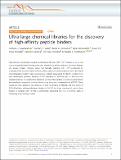| dc.contributor.author | Quartararo, Anthony James | |
| dc.contributor.author | Gates, Zachary P | |
| dc.contributor.author | Somsen, Bente A. | |
| dc.contributor.author | Hartrampf, Nina | |
| dc.contributor.author | Ye, Xiyun | |
| dc.contributor.author | Shimada, Arisa | |
| dc.contributor.author | Kajihara, Yasuhiro | |
| dc.contributor.author | Ottmann, Christian | |
| dc.contributor.author | Pentelute, Bradley L. | |
| dc.date.accessioned | 2020-10-27T20:18:24Z | |
| dc.date.available | 2020-10-27T20:18:24Z | |
| dc.date.issued | 2020-06 | |
| dc.date.submitted | 2019-12 | |
| dc.identifier.issn | 2041-1723 | |
| dc.identifier.uri | https://hdl.handle.net/1721.1/128217 | |
| dc.description.abstract | High-diversity genetically-encoded combinatorial libraries (108−1013 members) are a rich source of peptide-based binding molecules, identified by affinity selection. Synthetic libraries can access broader chemical space, but typically examine only ~ 106 compounds by screening. Here we show that in-solution affinity selection can be interfaced with nano-liquid chromatography-tandem mass spectrometry peptide sequencing to identify binders from fully randomized synthetic libraries of 108 members—a 100-fold gain in diversity over standard practice. To validate this approach, we show that binders to a monoclonal antibody are identified in proportion to library diversity, as diversity is increased from 106–108. These results are then applied to the discovery of p53-like binders to MDM2, and to a family of 3–19 nM-affinity, α/β-peptide-based binders to 14-3-3. An X-ray structure of one of these binders in complex with 14-3-3σ is determined, illustrating the role of β-amino acids in facilitating a key binding contact. | en_US |
| dc.description.sponsorship | NIH/NIGMS (Grant T32-GM008334) | en_US |
| dc.language.iso | en | |
| dc.publisher | Springer Science and Business Media LLC | en_US |
| dc.relation.isversionof | http://dx.doi.org/10.1038/s41467-020-16920-3 | en_US |
| dc.rights | Creative Commons Attribution 4.0 International license | en_US |
| dc.rights.uri | https://creativecommons.org/licenses/by/4.0/ | en_US |
| dc.source | Nature | en_US |
| dc.title | Ultra-large chemical libraries for the discovery of high-affinity peptide binders | en_US |
| dc.type | Article | en_US |
| dc.identifier.citation | Quartararo, Anthony J. et al. "Ultra-large chemical libraries for the discovery of high-affinity peptide binders." Nature Communications 11, 1 (June 2020): 3183 © 2020 The Author(s) | en_US |
| dc.contributor.department | Massachusetts Institute of Technology. Department of Chemistry | en_US |
| dc.contributor.department | Massachusetts Institute of Technology. Center for Environmental Health Sciences | en_US |
| dc.contributor.department | Koch Institute for Integrative Cancer Research at MIT | en_US |
| dc.relation.journal | Nature Communications | en_US |
| dc.eprint.version | Final published version | en_US |
| dc.type.uri | http://purl.org/eprint/type/JournalArticle | en_US |
| eprint.status | http://purl.org/eprint/status/PeerReviewed | en_US |
| dc.date.updated | 2020-09-21T14:56:31Z | |
| dspace.date.submission | 2020-09-21T14:56:33Z | |
| mit.journal.volume | 11 | en_US |
| mit.journal.issue | 1 | en_US |
| mit.license | PUBLISHER_CC | |
| mit.metadata.status | Complete | |
